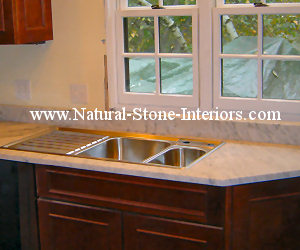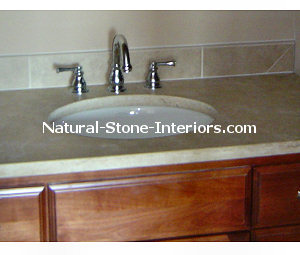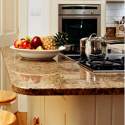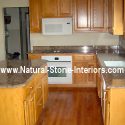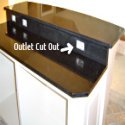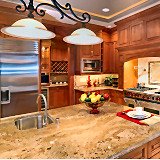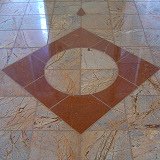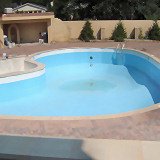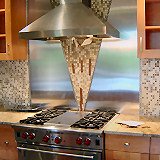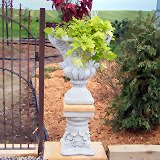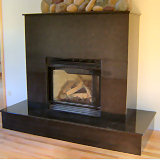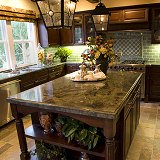 | ||||||||||||||||||||||
|
Loading
| ||||||||||||||||||||||
Using Natural Stone In Your HomeFAQ's
FAQ's On Using Natural Stone In Your Home
Is natural stone a good choice for home use? Knowing the different types of stone, their finishes and applications will help you to make an informed decision on which stone is the best stone for your project.
Can you explain the different finishes for stone?
Sealers DO NOT prevent staining as they are a moisture barrier only, yet they will help to give you a small amount of time to wipe up spills. It is nearly impossible to prevent staining or etching, but serious stains can be almost completely removed and any etching can be resurfaced if either is truly bothersome to you. To help keep a perspective on choosing natural stone, remember the following:
What is the best natural stone to use in my home?
The best advice that I can ever give to anyone choosing natural stone is: Go with what you are drawn to from the beginning. First, because you will only spend a lot of time and become confused when laboring over the "right" decision by looking at many different natural stones and colors. Secondly, you will probably not be happy with your selection if you have to settle on something else. Reviewing the following stone types will help when you are ready to make your choice.
GRANITES - Granites usually have a "spattered" or "swirled" grain and can contain many colors (minerals). Generally, granites have a polished finished and have a "busy" look, but to keep up with current trends, more manufacturers are producing honed (smooth and unpolished) and flamed (rough textured) surfaces. Granites may be purchased in slab and dimensional tile form and can be used in almost any application. It has become ever popular as it is being used frequently in newly built tract housing, apartment/condominium complexes and commercial buildings. Granites are imported from many countries and have just as many colors and sizes to choose from. As with any other commodity, natural stone is also graded for quality standards. Be wary if it is extremely inexpensive. (less than $7.00 per square foot UNLESS you are buying a large quantity.) The price ranges in granites can be anywhere in between $8.00 to $90.00 per square foot, depending on the color, rarity and where the stone comes from. The "blue" stones, containing minerals/gems such as sodalite are usually in the higher priced ranges.
LIMESTONES - There are many types of limestone available
and they vary to many degrees, depending upon where it comes from. Unpopular to belief, limestone is also a perfectly suitable
Most limestones have softer earth tone colors; may contain a "swirl" veining movement throughout; can contain fossils; or may have a light speckled grain. Limestones, just like granite or any other natural stone can stain, etch or get scratched, but again, you should not use natural stone if this will bother you. Limestone also is widely available in dimensional tile and slab form. This natural stone is used most frequently in higher-end homes, architectural designs and commercial applications as:
It is still considered to be a custom choice, as it has not reached the overuse level of granite. Some limestones from countries such as France and Portugal can be somewhat porous but are perfect for flooring, backsplashes, fireplace surrounds and outdoor uses. Limestone from countries such as the US and Israel (Jerusalem Stone) are generally heavier and usually as dense as granite, which makes it suitable for almost every application. SLATES - Slate used to be used mainly for chalkboards,
billiard tables, science lab areas and roof tiles. However, in recent years it has become more popular for residential use in most applications,
Slate tiles are generally rough in surface texture, with the exception of the tumbled version. Most slates are available in a wide variety of sizes in dimensional tiles; a few in slab form and most can be gotten in crates of random pieces like flagstone. It is a perfect stone for water areas such as showers & spas, patio/driveway areas, pool surrounds and roofing applications. Most slates contain a huge variation of color, even within the same lot and some will even look to have been stained from spills of red wine, which is not the case. This is caused from earth minerals such as iron and only adds to the beauty of the stone. Slate holds onto heat well, which is another reason besides being fire proof; it is widely used as roofing material. (Use light colors in outdoor areas where you may be walking barefoot!) Since slates have a softer property, be aware that it can shale off the surface more easily. This will not harm it per se, but may cause you concern if you are not aware that it happens. One of the difficulties of slate is that it is varied in thickness. Because of the shale properties, it is very difficult to cut evenly. Generally, manufacturers will cut them with a "gauged" thickness or "sawn back" treatment, leaving one side smoother. Because of the varied thickness between each piece of tile, specific sized installations may be more of a challenge, so expect your installer costs to be a bit higher. Slate itself is generally a less costlier stone. Expect anywhere from $4.00 - $8.00 per square foot of tile, dependent upon the grade and country of origin. Again, beware of any extremely inexpensive prices and be sure to check the quality of the slate to be sure that it has not been filled with dyes. Test by holding a piece under running water for a few minutes and also by putting a few tablespoons of vinegar or lemon juice on it and wiping off. If any color comes off, return it immediately!
MARBLE - Most people are familiar with marble in many uses.
From Greek statues to Roman baths, marble has been used for centuries in just about every possible application, both
interior and exterior. Marble has the same general properties of limestone and can stain, etch or scratch, but it only becomes more beautiful over time and use. It is readily available in just about every color, size, finish and texture known to man. Most marbles have a veining of a mineral throughout them and are generally thought to be from Italy, but it in actually it is quarried from all over the world. Tumbled marble has become extremely popular in the United States in the last few years for backsplash, flooring and shower areas. Prices range from $6.00 - $30.00 per square foot of tile, again dependent upon the rarity, color and country of origin. A couple of drawbacks to marble to be aware of is:
TRAVERTINE - Travertine is marble, except it is
filled with "holes." To understand what causes the holes, think of it this way. Wherever a river or stream was prior to the marble being
quarried is where you will find travertine. Because of the holes, people can be scared off because travertine is generally thought to be more porous and not suitable for residential use. This is not the case, as all of those holes become filled in with grout during installation, giving it a very unique look. The same travertine can be used in two separate areas but appear another way just by using two different grout colors! Travertine can be purchased with the holes pre-filled, but in my experience with it, I don't recommend it. In general, the epoxy fill that is used has a color to it that does not look natural to the stone and it has a tendency to come out after a short amount of time in high traffic areas. Expect to pay anywhere from $5.00 - $15.00 per square foot of tile.
Is Natural Stone more difficult or costly to install than ceramic tile? As for cost it is generally not more expensive except for worked on projects with. The setting supplies and procedures are the same, but stone is heavier to work with. I suggest talking it over with your installer and also taking the time to look at previous jobs he or she has installed if possible.
Can a stone design be used or mixed with other kinds of materials?
How do I figure the quantity that I will need?
When figuring for decorative tile or trim, it is usually by the piece and calculated by the lineal foot. For natural stone slabs, sometimes it is best to let your fabricator figure the quantity for you.
What size grout joints should I use? About the author: Kim has worked in the Building Industry for 19 years and has specialized in tile and stone for the last five, with emphasis on end-user and tile contractor drawing design specifications and visualization.
Here's MORE Stone STUFF:
Return from Using Natural Stone In Your Home to FAQ's On All Natural Stone Return from Using Natural Stone In Your Home to Natural Stone Interiors Home |
|
|||||||||||||||||||||
|
|
||||||||||||||||||||||
|
Top Of Page | Home Page | What's New | Free Estimates | Site Map | Privacy Policy | Advertising | Contact Us | | ||||||||||||||||||||||
|
Copyright © 2005 - 2015 Natural-Stone-Interiors.com - All Rights Reserved.
|
||||||||||||||||||||||
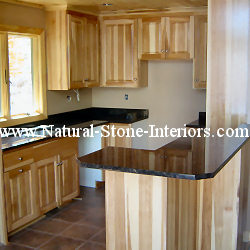
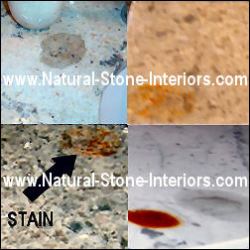
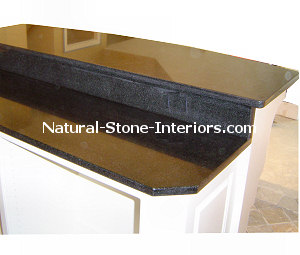
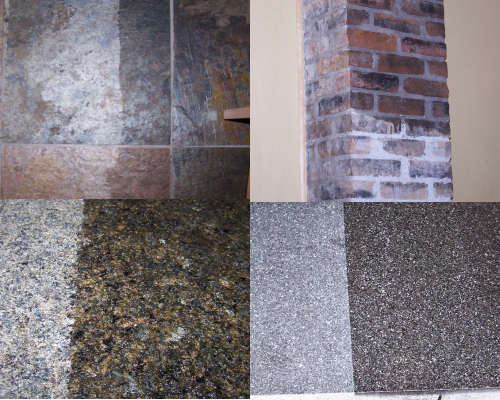
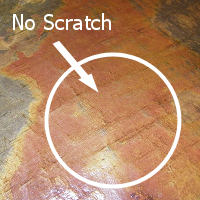
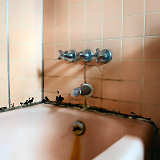
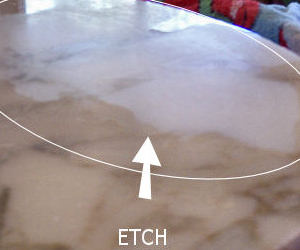
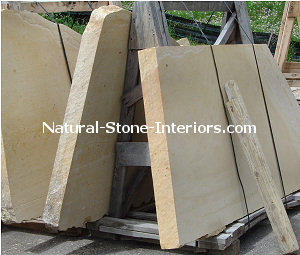 natural stone to use in all areas of your home.
natural stone to use in all areas of your home.
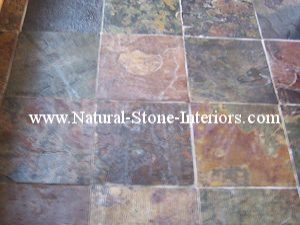 with the exception of fabricated counter tops.
with the exception of fabricated counter tops.